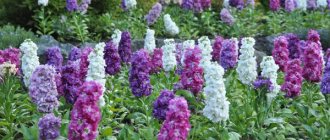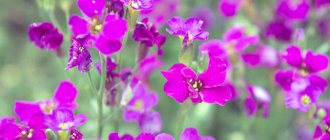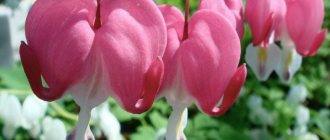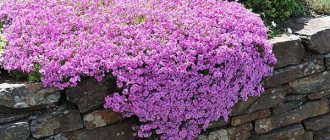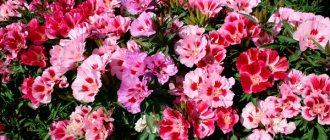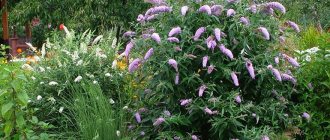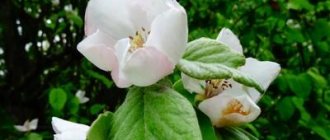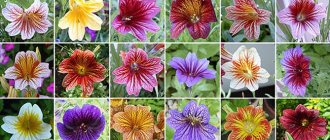The amazing world of flowers and plants never ceases to amaze grateful nature lovers. Various varieties of gazania, which are distinguished by their amazing color and uniqueness, do not stand aside. This flower belongs to the Asteraceae family, and is very reminiscent of a large chamomile. In most cases, after the first acquaintance with a plant, it is impossible to forget it. Therefore, gazania is increasingly appearing in garden or city flower beds.
The plant is characterized by increased resistance to parasites and various diseases. But if not properly cared for, gray rot may appear.
At the first sign of infection, the bushes should be removed at the root. The rest are treated with special herbal remedies. Learn about coreopsis in our next article!
general information
People very romantically called gatsaniya “midday gold,” and all because the flower opens most beautifully in the midday sun. This is a low plant, rarely more than 30 cm, with beautiful dark leaves and a short stem. On the reverse side, the leaf plates are slightly fleecy to protect against pests, frost and to retain moisture.
Despite their overall miniature size, gatsania flowers are quite large, blooming up to 10 cm. They look like baskets collected from smaller inflorescences. The most common colors are yellow, orange and red. One small plant can produce more than 30 buds.
Gatsania blooms around mid-summer, but some late varieties bloom in August. At the same time, she will decorate the garden with her colorful buds almost until the end of autumn.
Photo: mocah.org
Habitat and intricate names
The plant came to Europe from the exotic country of Mozambique, where various varieties of gazania grow in the wild. When our ancestors saw the flower, they may have thought: “What a majestic daisy!” But that was just the first impression. Having looked closely at the plant, botanists noticed a unique feature. Only when the midday heat sets in, its delicate petals open in all their glory, decorating the flower arrangements of the garden.
In nature, the flower is found throughout the African continent and in distant Australia.
Before considering the varieties of gazania, let's get acquainted with its intricate names. Some call the flower “Midday Sun” for its unique ability to open buds during strong sunshine. Recalling its origin, the plant was given the nickname “Nomad from Mozambique.” In Russia, flora fans call the flower “African chamomile.” But for some it’s just an exquisite garden gazania. Whatever this wonderful flower is called, it deserves special attention from gardeners.
Types of gatsaniya
Of the dozens of varieties of gatsania, several of the most popular can be identified. But breeders work every year to create new hybrid species with even more interesting colors!
Long rifle gatsaniya
This is a fairly tall variety for a gatsaniya - up to 20 cm. Bright yellow inflorescences with a brownish center reach up to 7 cm in diameter. Against their background, small carved leaves appear bluish.
Photo: liveinternet.ru
Peacock gazania
This variety differs from its relatives in the unusual shape of long and narrow leaves. They can reach up to 20 cm in length, and the main color of the buds is rich amber.
Photo: oir.mobi
Cirrus gazania
Another group of varieties got their name because of the feathery shape of the dissected leaves. They also have quite tall stems – up to 20 cm in height.
Photo: 2sotki.ru
Brilliant gatsaniya
The inflorescences of this species are slightly smaller - up to 6 cm, but there is a much greater richness of shades - from classic yellow to pink or dark brown. This type is also called harsh.
Photo: pxhere.com
Hybrid gatsaniya
This category unites all breeding hybrids that are valued for their excellent decorative properties. The fleecy leaves are cast in silver and are collected in dense rosettes, above which large bright buds bloom.
Photo: flo.discus-club.ru
Gatsania Potsi
This variety cannot be confused with others simply because the flowers of this gazania are simply gigantic. With a general stockiness of the plant, the baskets bloom up to 12 cm in diameter.
Photo: plodovie.ru
Single-flowered gazania
The miniature variety is grown as a creeping groundcover. Such bushes rarely rise above 10 cm in height, and during the flowering season the green carpet is densely covered with the same small, soft yellow flowers.
Photo: youscreen.ru
Eschscholzia (60 photos): types, planting and care in open ground
Widely used in landscape design
Of course, the elaborate gazania is wonderfully suitable for forming various types of garden design.
Thanks to its long flowering, it looks original in the company of the following flowers:
- lobelia;
- calendula;
- asters;
- majors;
- Iberis.
The ampelous gatsaniya shown in the photo fits wonderfully into the exterior of the veranda, gazebo, terraces and balconies. Bright inflorescences give the area a sophisticated and unique look.
African chamomile is often used to decorate borders. The plant is planted along garden paths in small groups. It looks absolutely stunning when in bloom. In landscape design, gatsaniya is widely used in the formation of alpine slides, various flower beds and rockeries. Most often, such popular varieties are grown as gazania Blestyashchaya, Peacock, Peristaya, Snow-White. It is impossible to remain indifferent to this sweet African guest.
Gatsaniya care
Gazania is an ideal flower for beginning gardeners because it is not at all demanding. In favorable weather conditions, all she needs is warmth and sun for a comfortable life.
Temperature
Gatsania grows best in warmth, and this applies to any stage of flower development. If the thermometer drops below 18 degrees during seed germination, the plant is unlikely to die, but the process will take much longer.
Photo: oir.mobi
Lighting
Bright sunlight is fundamentally important for gatsaniya. She is not afraid of direct rays and hot summer. On the contrary, even an almost imperceptible openwork shadow from the crown of the nearest tree can harm it.
Photo: 2sotki.ru
Watering
Gatsania tolerates short-term dryness better than constant dampness. It needs systematic watering as the soil dries out in the summer, but it must be moderate and quite rare. Wait until the soil is really dry.
Photo: stroymanual.com
The soil
As we have already said, gatsaniya does not tolerate excess moisture. And this is what determines the choice of soil for this delicate flower. The soil must be light, loose and with good drainage.
Photo: dachadecor.ru
Fertilizers and fertilizing
Abundantly flowering gatsaniya responds favorably to periodic complex feeding. But you don’t need to use them more often than once every 1-1.5 months. An exception may be poor rocky soils - then you need to look at the specific situation.
Photo: flo.discus-club.ru
Trimming
Gatsaniya does not require mandatory formation and preventive pruning, like other small garden flowers. But it is recommended to cut off faded buds immediately so that they do not waste the vitality of the plant.
Photo: sdelai-lestnicu.ru
Why doesn't gatsaniya bloom?
There are only three main reasons why the beautiful gatsaniya is in no hurry to produce buds. First of all, this is excessive watering, which can destroy the entire planting.
It is also a lack of sunlight, because even light partial shade can play a role. And the third reason is late planting, and in this case the gatsaniya simply does not have time to bloom.
Photo: kakuhazhivat.ru
Wintering
With annual varieties everything is clear - they just need to be removed at the end of the season. But perennials will have to be dug up, planted in containers and sent to winter in a well-lit but cool room at a temperature of 8-10 degrees with infrequent watering.
Photo: fotoload.ru
Flower Hazel grouse (50 photos): types, planting and care in open ground
Annual and perennial gatsaniya - cultivation and care in open ground
Gazania (gazania) gazania rigens – harsh or shiny. The name is derived from the Greek philosopher and humanist Theodore Gaza.
Short description
It grows naturally in South Africa and Australia, but is not very well known in our area. Belongs to the family Asteraceae L., belongs to a higher order of dicotyledons. Like chamomile, it is suitable for group plantings, including perennial compositions.
In nature, it is often found in the lower parts of alpine meadows. It grows in South Africa, Mozambique, Tanzania, Angola, and grows rapidly in Australia, New Zealand, California, and the Mediterranean. Due to its exotic origin and external resemblance to chamomile, it is called African chamomile. Perennial gazania has long narrow leaves, whole or patchy in shape. Leaves are:
- lanceolate;
- narrow;
- round.
The stem is surrounded by leaves forming a rosette. The leaf blade below is covered with hairs.
Caring for the plant is simple.
The flower blooms in various colors:
- white;
- cream;
- yellow;
- orange;
- red;
- rose red;
- mauve;
- red-brown.
Photo. Perennial plantings of gazania
Sometimes the middle is shaded: the inside is darker, the outside is lighter. The most common option is yellow.
Flowers close on cloudy, dark days, and open on sunny days. This is one of the most characteristic features of Gatsania. Not suitable for cutting, precisely because of the closure of the buds.
Photo. Closed gatsania buds on a cloudy day and at night.
The plant is undemanding in care and rarely gets sick if you provide it with the right conditions when planting.
Location, soil requirements, watering, fertilizer
It is best to plant gatsaniya in a sunny place. Even in lightly shaded displays, if there is not enough sunlight, perennial flowers will not grow. On cloudy days and rainy years, gatsaniya blooms poorly, the flowers remain closed and fall off.
Gatsania flowers, photo
Perennial African chamomile needs to be planted in fertile, not too wet, well-loosened garden soils. The pH value of the soil does not matter. On highly permeable soils, gatsaniya requires frequent watering during the first two weeks after planting. When a perennial young plant takes root, it tolerates short-term drought - care becomes easier.
The peculiarity of this perennial plant is that it tolerates drought well. If there is a lack of water, flowering is weaker, so it is recommended to water the gazania well in hot and dry weather. There is no need to water the plant too often or abundantly; it is enough to water as the soil dries. It is better to moisten the soil in the morning so that the water remaining on the leaves can dry out before night. This type of care for gatsaniya will help avoid fungal diseases on perennial bushes.
Some gardeners advise that in order to make gazania bloom longer and more abundantly, constantly remove faded flowers and add a little fertilizer with each watering.
It's worth knowing! To prolong the flowering of gatsaniya, you need to trim off faded flowers.
Gatsania can be planted in ridges, flower beds, rock gardens, in containers, or in a pot at home. Perennial African chamomile grown in a container is more demanding in care - regular watering and fertilizer are required. Avoid over-irrigating perennial plants grown in pots because they do not tolerate waterlogging well. Before the next watering, you need to wait until the soil dries. The bottom of the pot requires drainage and a protective drain. Every 14 days after planting, the flower is fed with fertilizer for perennial flowering plants.
Photo. Perennial home gatsaniya on the windowsill
How to preserve gatsaniya in winter?
Gazania brilliant is usually grown as an annual plant, but under the right conditions it can be given the opportunity to be perennial by preserving the bushes for the winter.
In order for the plant to overwinter and become a perennial, preparations for winter are carried out. The stages of work are as follows:
- All flowering shoots need to be cut off.
- Before the first frost, the African flower is dug out of the soil and planted in a pot.
- The pot is placed in a dry place, well illuminated by natural light, where the temperature in winter does not fall below 0 °C. The optimal wintering temperature for gatsaniya is 5-10 degrees Celsius. The substrate in the pot is kept slightly moist throughout the winter so as not to dry out the roots. This way the flower is preserved until next year, and gatsanya becomes perennial.
- At the end of February, the plant is divided and transplanted into fresh soil. During the next stage, the pot is moved to a warmer, brighter room (air temperature is maintained at 15 ° C) and watering begins more often to slowly awaken the perennial from winter dormancy.
- After May 15, in cold regions in early June, when the risk of frost has passed, you can begin planting in open ground.
Planting and propagation
Gatsania is planted from seeds through seedlings. It is best to start the process in late March or early April. And we immediately recommend taking a tall and deep container, because the tap root of the color quickly deepens.
We recommend planting gatsania immediately at a distance of a couple of centimeters, lightly pressing the seeds into the ground. Then they grow under the film, but it needs to be ventilated daily and condensation removed. In just 2 weeks you will see sprouts.
If picking is necessary, it is carried out after the appearance of 4-5 leaves. After this, the plant can be gradually accustomed to the street and hardened, so that at the end of May it can be transplanted into open ground.
Photo: solislandscapingservice.com
Description and main characteristics of gatsaniya
The South African flower gatsaniya (or gazania) is a bit like a chamomile in appearance, which is why it was called that. This is a low-growing plant of the Astrov family, which came to Europe in the middle of the 18th century, and was named after the Italian priest T. von Gas. It grows wild in Africa and coastal areas of Australia.
Gazania flower
Gatsania flowers are formed on a smooth, tubular stem 25 cm high and reach a diameter of 5-12 cm. The color depends on the variety and can be almost any: snow-white, rich or pale yellow, orange, all imaginable shades of pink, red. A distinctive feature is the darker and more contrasting strokes going towards the center of the flower.
For your information! The plant begins to bloom 3-4 months after planting the seeds. Its duration is determined by climatic conditions.
Gatsania has a flexible aerial part that creeps along the ground, the taproot. The leaves and stems are fleecy, silvery in color, and milky juice oozes out when cut. The upper part of the leaves is smooth, bright or dark green. The seeds are thin, elongated, black and white, with a small tuft.
Pest and disease control
Gazania is a rather delicate flower and is susceptible to pests such as aphids and spider mites. In this case, it is better to prevent the attack in advance and treat the garden prophylactically with insecticides. In addition, some fragrant herbs nearby repel parasites.
Another problem is snails. They will have to be removed mechanically, or their natural enemies, such as hedgehogs or birds, will be attracted. For preventive spraying, spicy herbs, tea, coffee and hot pepper are used.
Of the diseases, gatsaniya is most often affected by gray rot, because this flower is very sensitive to high humidity. Brown spots appear on the leaves and grow rapidly.
Don't plant seedlings too close, thin out as needed, don't overwater the leaves, and remove all affected areas immediately. To treat a diseased plant, use fungicides or other specialized preparations.
Photo: albinos76.livejournal.com
Daffodils (60 photos): types, planting and care in open ground
Peculiarities
Gazania does not require specific environmental conditions to grow. The flower only needs a small amount of moisture, warmth and sunlight.
When planning to plant a plant at your dacha, it is recommended to familiarize yourself with the peculiarities of growing a crop:
| Advantages | Flaws |
| It is allowed to plant in open areas and at home in a pot. Gazania will always bloom very luxuriantly, even if you do not add fertilizer to the soil. | The flower does not tolerate drafts. |
| Suitable for cultivation in absolutely any climatic conditions. But for mid-latitudes, shrubs will need to be dug up for wintering. In the southern regions, gazania can grow in a flower bed all year round. | With prolonged cold weather, the plant's inflorescences and foliage may become deformed. |
| The flower crop can withstand sudden changes in temperature well. The flower tolerates dry weather well. Therefore, watering the plant does not need to be done daily. | The soil layer should not be clayey. This is due to the fact that moisture constantly stagnates in heavy soil, which the flower can hardly tolerate. |
| Gazania can grow both on fertile soil and on sandstone or on rocky and poor soil. The quality of the soil layer is not the main factor when cultivating the plant. | The plant will not bloom profusely and develop rapidly if its leaves receive very little sunlight. |
| The flower has many different types and varieties, the colors of which are quite bright and attractive. Therefore, the plant is often planted in a flowerbed next to other crops. | Flower crops are not recommended to be planted in areas with a monsoon climate, where huge amounts of precipitation constantly fall. |
| The seeds have good and fast germination. Young seedlings develop very quickly. Therefore, it is permissible to sow seedlings in open ground in May. |
Thanks to its original color, gazania can decorate any garden and personal plot. To create a beautiful landscape design, it is recommended to look at a photo of a flower in a flowerbed with other plants in advance.
Gatsaniya – photo
Blooming gazania really looks like a little sun in the garden. Just look how bright and spectacular they are!
Photo: instagram.com
Photo: flo.discus-club.ru
Photo: prorastet.ru
Photo: kakuhazhivat.ru
Photo: vkusnosushi.ru Photo: fotokto.ru
Photo: nn.ru
Photo: koffkindom.ru
Photo: oir.mobi
Photo: bazaogoroda.ru Photo: semenafermeru.ru
Photo: ferma.expert Photo: 2sotki.ru
Photo: agbina.ru
Photo: fl-garden.ru
Photo: botanichka.ru
Photo: w-dog.ru
Photo: agbina.ru
Photo: ya-fab.ru
Photo: koffkindom.ru Photo: zen.yandex.ru
Photo: batf.ru
Photo: na-dache.pro
Photo: 2sotki.ru
Did you like the post? Subscribe to our channel in Yandex.Zen, it really helps us in our development!
Growing gatsaniya from seeds
Growing gatsania from seeds is the main method of flower propagation. To admire the blooming of African chamomile, you will have to put a lot of effort into caring for the fragile, heat-loving seedlings. Each cultivar requires a special approach to cultivation, but the general rules apply to all varieties of the plant.
Preparation of seed material
The seed of hybrid varieties of gazania is represented by a wide range of varieties. You can purchase seeds at any store, but it is better to make a purchase at a trusted retail outlet, having first studied reviews about the manufacturer of the material on gardening forums. In this case, it is important to pay attention to the date of seed collection, since germination quickly decreases.
It is advisable that no more than a year pass from the time of collection. It is equally important to choose the right crop variety. Pay attention to cold resistance and the length of the flowering period. By purchasing variety mixtures, you can decorate the flower garden with daisies of different colors, their height will be equalized.
You can collect seeds of botanical species yourself. They ripen for a long time, and after full ripening the achenes quickly scatter under the influence of the wind. To avoid missing the moment of ripening, wrap the flower head with gauze. Store collected material in paper bags at room temperature and low humidity.
Remember! In hybrid gatsanias, fertile reed flowers are sterile. There is no point in collecting seed from such plants.
Pre-sowing preparation of seeds involves disinfection. This procedure is required for self-collected material and purchased achenes. You can use a pink solution of potassium permanganate or fungicides - Fundazol, Topaz, Fitosporin. Pickling time is 15-20 minutes. After disinfection, be sure to rinse the achenes in clean water several times.
Requirements for planting container and substrate
Gatsanias do not show any special requirements for the nutritional value of the substrate, but they develop and bloom better on cultivated soils. Good drainage and breathability are important for African chamomile. Choose a ready-made peat-based soil mixture with a pH of 5.5-6.5. To improve the structure, add coarse calcined sand or vermiculite to the purchased soil in a 3:1 ratio.
Experienced gardeners note that gazania seedlings develop well in peat or coconut tablets. Since the crop has a long tap root, select a large washer.
For growing gatsania seeds, containers are selected that prevent picking. Individual peat or plastic pots and cassettes with a volume of 500-700 ml are suitable. This is due to the structure of the root system. Damage to the central stem of the seedling often leads to its death.
Advice! If you decide to grow gazania seedlings in a common box, select a container with a height of at least 15 cm. A prerequisite for any container is the presence of drain holes in the bottom.
How and when to sow seeds for seedlings
It will take gazania 90-110 days to develop lush green mass and first flower stalks. The timing of sowing seeds for seedlings depends on the climatic characteristics of the region and the desired flowering time. If you want to get flowering specimens by the time of planting, you should not delay the sowing work.
In central Russia, seedlings are sown from mid-February. In this case, the senets need to be provided with an additional source of light. The best option is to purchase a phytolamp or cold glow bulbs. In colder regions (Siberia, the Urals), sowing work is postponed to the end of March. Direct sowing of seeds in a flowerbed is also possible, but you will only be able to admire the bright baskets in the fall.
Sowing technology:
- Fill the bottom of the planting container with fine expanded clay to a height of 2-3 cm.
- Place a nutritious soil mixture on top of the drainage; a day before sowing, water the prepared substrate generously.
- Arrange the pickled achenes in a checkerboard pattern, keeping a step between them of 2-3 cm.
- Sprinkle the seeds with a thin layer of soil or gently press them onto the surface of the soil.
- When using individual containers or peat tablets, make a small depression in the center and place 2 seeds in it.
- Spray the crops with a spray bottle, cover with film, and place under diffused light.
On a note! Before emergence, ventilate the container daily and remove drops of condensation from the film or glass. Keep the pots at a temperature of 18-22⁰C. Seedlings will appear in 10-14 days.
Seedling care
African seedlings will not require any special care from you. When growing seedlings, you need to provide good diffused lighting for 12 hours. Use additional lighting if necessary. With the emergence of seedlings, transfer the boxes to a cool place with a temperature no higher than 18⁰C, remove the film. Protect delicate plants from drafts!
African chamomile is a drought-resistant crop, but when growing seedlings in peat tablets, it is important to prevent the earthen coma from drying out. Maintain moderate watering; when irrigating, make sure that moisture does not linger on the foliage. It is better to plant each individual in a separate pot, but if picking (cultivation in a common box) is necessary, carry out the activity as early as possible - when the third leaf appears. Remove the seedling with a small scoop and, together with the earthen lump, transfer it into a larger container.
During cultivation at home, gazania seedlings need to be fed 2-3 times with a complete mineral complex. After picking or at the development stage of 3-4 leaves, apply nitrogen-based fertilizer, and before planting, strengthen the immune system with potassium fertilizer.
Important! Be sure to harden off the seedlings 2-3 weeks before transplanting to a permanent location. Although gatsaniya can withstand frosts down to -5⁰C, prepared seedlings quickly adapt to new conditions.
Care after landing
Seedlings do not require special care, the main thing is to follow the watering regime. The procedure must be carried out as the soil dries. Overwatering will lead to rotting of the root system and death of sprouts. If the soil is allowed to dry out, the seedlings will wither.
Comfortable temperature conditions for seedlings range from + 18…20 °C. It is necessary to exclude drafts and sudden decreases/increases in temperature. In case of insufficient lighting or short daylight hours, you need to provide the flower with additional lighting using special lamps.
Once a month the plant needs to be fertilized. You can buy it in a specialized store and dilute it in water for irrigation. Fertilizer is added strictly at the root; do not allow it to get on the leaves.
Collecting seeds and preparing flowers for winter
The overwhelming majority of gazania species and varieties do not produce seeds, but in case of a successful combination of circumstances and a hot summer, the gardener will be the happy owner of seed material for the next year. To catch the moment when the seeds begin to spill out of the box, you can put a homemade bag made of light fabric or gauze on one of the dried flowers. Saving midday sun seeds can last for two years in a cool place.
If all your expectations for the seeds to appear are in vain, do not despair! You can solve the problem and save the bushes in a different way: all plants will survive the winter well if they are carefully transplanted back into pots and moved to an apartment, house or greenhouse. In addition to extremely moderate watering, light soil and plenty of sunlight, the main condition for wintering is a temperature of at least +10°C.
Wintering gatsaniya at home
The perennial nature of gazania allows it to be cultivated in winter at home. Before frost sets in, transplant the bush into a spacious pot and bring it indoors. For some time, bright baskets will decorate the windowsill, and closer to winter, the pots should be moved to a cool, well-lit place. The optimal temperature is not higher than 10⁰C. The irrigation regime is moderate; if necessary, the bush is illuminated with a phytolamp.
Important! Before planting in a flower bed next spring, shorten the stems by half.
Description of the plant
Gatsania is an annual or perennial that is a low-growing plant with a short stem and dense, grayish-green or dark green leaves of various shapes. The underside of the leaf blade is covered with thick silvery fibers, which in dry times retain the moisture necessary for the plant.
Inflorescences up to nine centimeters in diameter consist of reed flowers. They can be yellow, red or orange. At the base of the bud, around the yellow center, there are dark spots. The center of the flower is assembled from tubular flowers. Each plant can produce up to thirty inflorescences. After flowering, hairy achenes with a tuft ripen on the bush - these are the fruits of gazania, which contain seeds.

